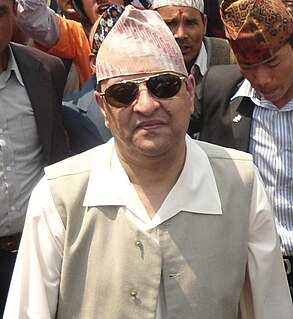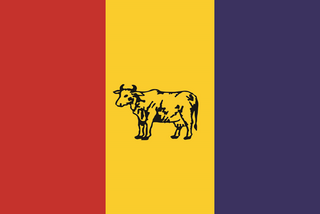
The politics of Nepal function within a framework of a republic with a multi-party system. Currently, the position of President of Nepal is occupied by Bidhya Devi Bhandari. The position of Prime Minister is held by Khadga Prasad Oli. Executive power is exercised by the Prime Minister and his cabinet, while legislative power is vested in the Parliament.

The Kingdom of Nepal, also known as the Kingdom of Gorkha or Gorkha Empire or the self designated Asal Hindustan, was a Hindu kingdom on the Indian subcontinent, formed in 1768, by the unification of Nepal. Founded by King Prithvi Narayan Shah, a Gorkhali monarch of Rajput origin from medieval India, it existed for 240 years until the abolition of the Nepalese monarchy in 2008. During this period, Nepal was formally under the rule of the Shah dynasty, which exercised varying degrees of power during the kingdom's existence.
The United States order of precedence lists the ceremonial order for domestic and foreign government officials at diplomatic, ceremonial, and social events within the United States and abroad. Former presidents, vice presidents, first ladies, second ladies, and secretaries of state and retired Supreme Court justices are also included in the list. The order is established by the president, through the Office of the Chief of Staff, and is maintained by the State Department's Office of the Chief of Protocol. It is only used to indicate ceremonial protocol and has no legal standing; it does not reflect the presidential line of succession or the co-equal status of the branches of government under the Constitution. The Office of the Chief of Protocol posted an updated order of precedence on November 3, 2017.

Gyanendra Bir Bikram Shah Dev reigned as the last King of Nepal from 2001 to 2008 and is also known as the world's last Hindu King. As a child, he was briefly king from 1950 to 1951, when his grandfather, Tribhuvan, went into exile in India with the rest of his family. His second reign began after the 2001 Nepalese royal massacre.

The New Zealand Royal Honours system, a system of orders, decorations and medals, recognises achievements of, or service by, New Zealanders or others in connection with New Zealand. Until 1975 New Zealand used the British honours system. Since then the country has introduced a number of uniquely New Zealand honours, and as of 2018 only the dynastic British honours continue in active use in New Zealand, with the exception of the Order of the Companions of Honour.

The Nepalese Civil War was a civil war in Nepal fought between the Communist Party of Nepal (Maoist) (CPN-M) and the government of Nepal from 1996 to 2006. The insurgency period is known as the Maovadi dwandakaal in Nepal. The rebellion was launched by the CPN-M on 13 February 1996 with the stated purpose of overthrowing the Nepalese monarchy and establishing a People's Republic. It ended with the signing of the Comprehensive Peace Accord on 21 November 2006. The conflict was characterized by summary executions, massacres, purges, kidnapping and other war crimes and crimes against humanity. The insurgency resulted in deaths of over 17,000 people including civilians, insurgents, army and police personnel, and internal displacement of hundreds of thousands of people. According to INSEC, 1,665 of the dead were women.

Pushpa Kamal Dahal, commonly known by his nom de guerrePrachanda, is a Nepalese politician, co-chair of the Nepal Communist Party and twice Prime Minister of Nepal, from 2008 to 2009 and from 2016 to 2017.

The Rastriya Prajatantra Party is a royalist political party in Nepal. It was formed by former Prime Ministers, Surya Bahadur Thapa and Lokendra Bahadur Chand. The party has had two Prime Ministers, Thapa and Chand, serving two terms each since the end of the Rastriya Panchayat.
Himani Shah, Former Crown Princess of Nepal is the wife of the former heir apparent to the throne of Nepal, Crown Prince Paras.

Nepal Sambat is the lunar calendar used by the Nepalese-speaking people native to the Indian subcontinent of Nepalese nationality and ethnic Nepalis. The Calendar era began on 20 October 879 AD, with 1140 in Nepal Sambat corresponding to the year 2019–2020 AD. Nepal Sambat appeared on coins, stone and copper plate inscriptions, royal decrees, chronicles, Hindu and Buddhist manuscripts, legal documents and correspondence. Though Nepal Sambat is declared as national calendar, it is not used widely in Nepal. It is mostly used by Newar community whereas Bikram Sambat(B.S) remains the dominant calendar throughout the country. All the major festivals are based on Bikram Sambat along with the official purposes.

The Dekoratie voor Trouwe Dienst, post-nominal letters DTD, is a South African military decoration. It was instituted in 1920 as a retrospective award for Boer officers of the 1899–1902 Second Boer War.
Komal Rajya Lakshmi Devi Shah is the Queen consort of King Gyanendra of Nepal. She was the last Queen consort of Nepal before the Monarchy was abolished on 28 May 2008.

The King of Nepal was Nepal's head of state and monarch from 1768 to 2008. He served as the head of the Nepalese monarchy—Shah Dynasty. The monarchy was abolished on 28 May 2008 by the 1st Constituent Assembly. The subnational monarchies in Mustang, Bajhang, Salyan, and Jajarkot were also abolished in October.

Kamal Thapa served as a Deputy Prime Minister and Federal Affairs and Local Development Minister of Nepal Government. He is also current president of Nepal's royalist party, the Rastriya Prajatantra Party. He served as a Home Minister during King Gyanendra's direct rule in 2006 until the king was forced to handover power to Girija Prasad Koirala of the Nepali Congress Party and his allies with Communist Party of Nepal and Unified Communist Party of Nepal (Maoist). He and his party called for a re-establishment of the monarchy through a referendum vote. Thapa claims that no political parties in Nepal have the courage to safeguard Nepali nationality, claiming: "Now the onus lies only with the institution of monarchy to safeguard Nepali sovereignty and national unity."

Gagan Thapa is a Nepali politician and youth leader who served as the Minister of Health and Population of Nepal from 2016 to 2017. He is currently serving as a Member of Parliament in the House of Representatives, Nepal from Kathmandu since 2008, and is currently in its Parliamentary Committee on Education and Health. He is a Central Committee Member of the Nepal Congress Party.
The Malaysian order of precedence is a hierarchy of important positions within the Government of Malaysia. It has no legal standing but is used by ceremonial protocol. The order of precedence is determined by the Federal Order of Precedence issued by the Prime Minister's Department. The latest one was issued on 13 November 2014. Unless otherwise noted, precedence among persons of equal rank is determined by seniority. As a general rule, spouses share the same rank with another and a person with two positions will take the highest one.
The Sabah order of precedence is a hierarchy of important positions within the state of Sabah, Malaysia. It has no legal standing but is used by ceremonial protocol. The order of precedence is determined by the State Order of Precedence issued by the Sabah Chief Minister's Department. The latest one was issued on 1 September 1996 with amendments entered into force on 3 October 2003. Unless otherwise noted, precedence among persons of equal rank is determined by seniority. As a general rule, spouses share the same rank with another and a person with two positions will take the highest one.

Sarbottam Dangol, politically known as 'Kailash' is a prominent Nepalese leader of Nepal Communist Party (NCP) and a former central committee member of Communist Party of Nepal (Maoist-Centre). He stood as a candidate for the mayor post of Kathmandu Metropolitan City in May 2017. He also stood for the election in 2008 Nepalese constituent Assembly from Kathmandu area no. 8.

The Provinces of Nepal were formed on 20 September 2015 in accordance with Schedule 4 of the Constitution of Nepal. The seven provinces were formed by grouping the existing districts. The current system of seven provinces replaced an earlier system where Nepal was divided into 14 Administrative Zones which were grouped into five Development Regions.















